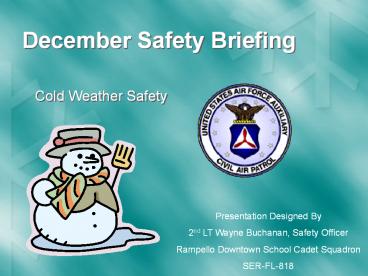December Safety Briefing Cold Weather Safety Presentation PowerPoint PPT Presentation
1 / 10
Title: December Safety Briefing Cold Weather Safety Presentation
1
December Safety Briefing
- Cold Weather Safety
Presentation Designed By 2nd LT Wayne Buchanan,
Safety Officer Rampello Downtown School Cadet
Squadron SER-FL-818
2
- As a Civil Air Patrol Member I pledge to promote
an uncompromising safety environment for myself
and others, and to prevent the loss of, or damage
to Civil Air Patrol assets entrusted to me. I
will perform all my activities in a professional
and safe manner, and will hold myself accountable
for my actions in all of our Missions for America.
3
THE COLD ENVIRONMENT
- When body temperature drops even a few degrees
below its normal temperature of 98.6ºF (37ºC),
the blood vessels constrict, decreasing
peripheral blood flow to reduce heat loss from
the surface of the skin. - Shivering generates heat by increasing the body's
metabolic rate. - During cold weather about
- 60 percent of a person's body
- fuel is used to heat the body.
4
MAJOR RISK FACTORS FOR COLD-RELATED STRESSES
- Wearing inadequate or wet clothing (increases the
effects of cold on the body). - Taking certain drugs or medications such as
alcohol, nicotine, caffeine, and medication that
inhibit the body's response to the cold or
impairs judgment. - Having a cold or certain diseases, such as
diabetes, heart, vascular, and thyroid problems
(may make a person more susceptible to the winter
elements).
5
- Being male (men have far greater death rates from
cold exposure than women, perhaps due to inherent
risk-taking activities, body-fat composition or
other physiological differences). - Becoming exhausted or immobilized, especially due
to injury or entrapment (may speed up the
effects of cold weather. - Being elderly.
6
WEARING THE RIGHT CLOTHING
- Dress in layers, wearing warm, waterproof/resistan
t clothing. - Pay special attention to protecting feet, hands,
face and head. Up to 40 percent of body heat can
be lost when the head is exposed. - Wearing multiple layers of varying thickness
allows you to regulate your body temperature. - You should flexibly layer the clothing and use
proper materials so you will stay warm and still
not restrict your movement.
7
HARMFUL EFFECTS OF COLD FROSTBITE AND
HYPOTHERMIA
- Frostbite occurs when the skin tissue actually
freezes, causing ice crystals to form between
cells and draw water from them, which leads to
cellular dehydration. - Although this typically occurs at temperatures
below 30ºF (-1ºC), wind chill effects can cause
frostbite at above-freezing temperatures.
8
Symptoms of Hypothermia
- General Hypothermia occurs when body temperature
falls to a level where normal muscular and
cerebral functions are impaired. While
hypothermia is generally associated with freezing
temperatures, it may occur in any climate where a
person's body temperature falls below normal. - The first symptoms of hypothermia, shivering, an
inability to do complex motor functions,
lethargy, and mild confusion, occur as the core
body temperature decreases to around 95ºF (35ºC).
9
- As body temperature continues to fall,
hypothermia becomes more severe. The individual
falls into a state of dazed consciousness,
failing to complete even simple motor functions.
The victim's speech becomes slurred and his or
her behavior may become irrational. - The most severe state of hypothermia occurs when
body temperature falls below 90ºF (32ºC). As a
result, the body moves into a state of
hibernation, slowing the heart rate, blood flow,
and breathing. Unconsciousness and full heart
failure can occur in the severely hypothermic
state.
10
Treatment for Frostbite Hypothermia
- If you suspect frostbite, you should seek medical
assistance immediately. Any existing hypothermia
should be treated first. Frostbitten parts
should be covered with dry, sterile gauze or
soft, clean cloth bandages. - Treatment of hypothermia involves conserving the
victim's remaining body heat and providing
additional heat sources. - SEEK IMMEDIATE MEDICAL ATTENTION!

